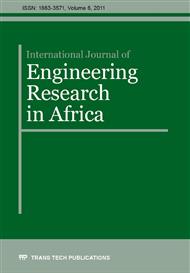[1]
Iowa Waste Reduction Center, Cutting fluid management manual: a practical pollution prevention guide, third edition, University of Northern Iowa, U.S.A. (2003) 1-61.
Google Scholar
[2]
J.L.C. Salles and M.T.T. Goncalves, Effects of machining parameters on surface quality of the ultra high molecular weight polyethylene", Revista Materia 8: 1 (2003) 1-10.
Google Scholar
[3]
M.C. Shaw, Metal cutting principles. Oxford Science Publications, Clarendon Press, Oxford, (1984).
Google Scholar
[4]
S. Kalpakjlan and S.R. Schmid, Manufacturing engineering and technology, 4th edition, Prentice Hall, New Jersey, (2001).
Google Scholar
[5]
A.E. Diniz and D.R. Micaroni, Cutting conditions for finish turning process aiming the use of dry cutting, International Journal of Machine Tools and Manufacture 42: 8 (2002) 889-904.
DOI: 10.1016/s0890-6955(02)00028-7
Google Scholar
[6]
L. De Chiffre, Function of cutting fluid in machining, Lubrication Engineering 44: 6 (1988) 514-518.
Google Scholar
[7]
P. Byers, Metal working fluids, third edition, Marcel Dekker Incorporation, New York, (1994).
Google Scholar
[8]
J. Jacob, M. Bhattacharya and P.C. Raynor, Emulsions containing vegetable oils for cutting fluid application, Colloids Surf. A: Physicochem. Eng. Aspects 237 (2004) 141-150.
DOI: 10.1016/j.colsurfa.2003.12.029
Google Scholar
[9]
N.H. Jayadas and P.K. Nair, Coconut oil as base oil for industrial lubricants – evaluation and modification of thermal, oxidative and low temperature properties. Tribology International 39 (2006) 873-878.
DOI: 10.1016/j.triboint.2005.06.006
Google Scholar
[10]
U. Krahenbuhl, Cutting fluid: vegetable oil based coolants improve cutting performance, Tooling and Production, Blaser Swisslube Incorporation, Ohio, (2007).
Google Scholar
[11]
M.A. Xavior and M. Adithan, Determining the influence of cutting fluids on tool wear and surface roughness during turning of AISI 304 austenitic stainless steel, Journal of Material Processing Technology. 02 (2008) 68-78.
DOI: 10.1016/j.jmatprotec.2008.02.068
Google Scholar
[12]
S. Skerlos and Hayes, K. (2007). Vegetable Based Cutting Fluid. A New Dimension in Research, 2007 (www. engn. umich. edu. Accessed in July 2009).
Google Scholar
[13]
A. Bhattacharya, Metal cutting theory and practice, second edition, Central Book Publishers, Calcutta, (1984).
Google Scholar
[14]
E.O. Ezugwu, R.B. Da Silva, J. Bonney and A.R. Machado, Evaluation of the performance of CBN tools when turning Ti-6Al-4V alloy with high pressure coolant supplies, International Journal of Machine Tools and Manufacture 45 (2005) 1009-1014.
DOI: 10.1016/j.ijmachtools.2004.11.027
Google Scholar
[15]
P. Sirisomboon, P. Kitchaiya, T. Pholpho and W. Mahuttanyavanitch, Physical and mechanical properties of Jatropha curcas L. fruits, nuts and kernels. Biosystem Engineering, 97 (2007) 201-207.
DOI: 10.1016/j.biosystemseng.2007.02.011
Google Scholar
[16]
I.M. Dagwa and A.O.A. Ibhadode, Determination of optimum manufacturing conditions for asbestos-free brake pad using Taguchi method, Nigerian Journal of Engineering Research and Development 5: 4 (2006) 1-8.
Google Scholar
[17]
G.S. Peace, Taguchi Methods: A Hands-On Approach, Addison-Wesley Publishing Company Inc, Reading, Massachusetts, (1993).
Google Scholar


